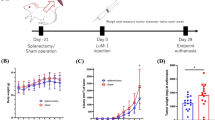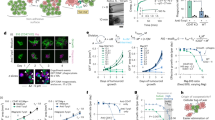Abstract
Two rapidly growing allogeneic tumours, sublines of Yoshida (Y-P388) and Walker (W-256) injected intravenously in single cell suspensions produced tumour macrocolonies in the lungs of rats within 7 days. Y-P388 produced similar but fewer colonies in the kidneys. Colony forming efficiency (CFE) in lung was high in weanling rats given either sublethal whole body irradiation (WBI) or a single dose of rabbit anti-rat lymphocytic serum (ALS) to suppress immunity. In immunologically intact weanlings CFE was much lower and many 7-day old colonies showed signs of regression. CFE for primary tumour cell challenges decreased rapidly and markedly with increase in age of host during the first 1-2 weeks after weaning. This resistance to growth of a primary challenge in lungs of older rats was not significantly reduced by WBI but was decreased by ALS. CFE of a secondary challenge of tumour cells injected intravenously in rats which had been previously immunized with heavily irradiated (HR) tumour cells was very low; it was not significantly increased by WBI but was moderately increased by ALS. In weanling rats given lethal (900 rad) WBI, 1 hour before intravenous injection of tumour cells, treatment with bone marrow (BM) cells derived from normal adult donors increased CFE, whereas BM (or spleen) cells from immunized donors decreased CFE. The results suggest that ALS and WBI not only increase tumour CFE by suppressing immunity to tumour growth but also “condition” host tissue (tumour bed) in such a way as to facilitate the survival, “take” and initial replication of grafted tumour cells before the rats recover from the immunosuppressive effects of these treatments.
This is a preview of subscription content, access via your institution
Access options
Subscribe to this journal
Receive 24 print issues and online access
$259.00 per year
only $10.79 per issue
Buy this article
- Purchase on Springer Link
- Instant access to full article PDF
Prices may be subject to local taxes which are calculated during checkout
Similar content being viewed by others
Rights and permissions
About this article
Cite this article
van den Brenk, H., Sharpington, C. & Orton, C. Macrocolony Assays in the Rat of Allogeneic Y-P388 and W-256 Tumour Cells Injected Intravenously: Dependence of Colony Forming Efficiency on Age of Host and Immunity. Br J Cancer 27, 134–152 (1973). https://doi.org/10.1038/bjc.1973.18
Issue Date:
DOI: https://doi.org/10.1038/bjc.1973.18



